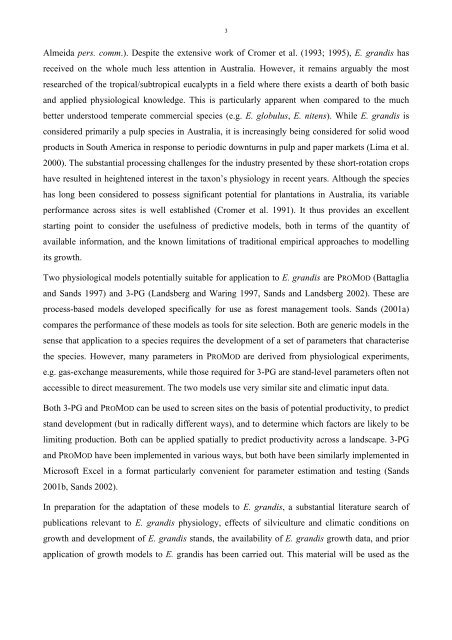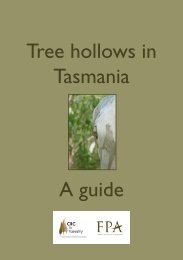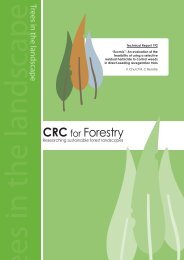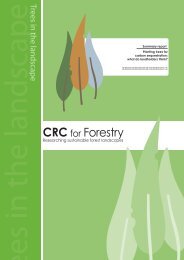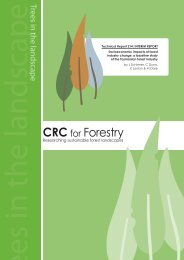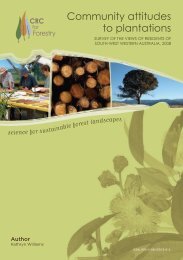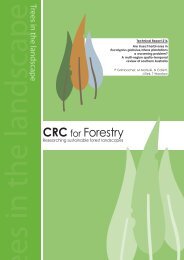Download public report. - CRC for Forestry
Download public report. - CRC for Forestry
Download public report. - CRC for Forestry
Create successful ePaper yourself
Turn your PDF publications into a flip-book with our unique Google optimized e-Paper software.
3<br />
Almeida pers. comm.). Despite the extensive work of Cromer et al. (1993; 1995), E. grandis has<br />
received on the whole much less attention in Australia. However, it remains arguably the most<br />
researched of the tropical/subtropical eucalypts in a field where there exists a dearth of both basic<br />
and applied physiological knowledge. This is particularly apparent when compared to the much<br />
better understood temperate commercial species (e.g. E. globulus, E. nitens). While E. grandis is<br />
considered primarily a pulp species in Australia, it is increasingly being considered <strong>for</strong> solid wood<br />
products in South America in response to periodic downturns in pulp and paper markets (Lima et al.<br />
2000). The substantial processing challenges <strong>for</strong> the industry presented by these short-rotation crops<br />
have resulted in heightened interest in the taxon’s physiology in recent years. Although the species<br />
has long been considered to possess significant potential <strong>for</strong> plantations in Australia, its variable<br />
per<strong>for</strong>mance across sites is well established (Cromer et al. 1991). It thus provides an excellent<br />
starting point to consider the usefulness of predictive models, both in terms of the quantity of<br />
available in<strong>for</strong>mation, and the known limitations of traditional empirical approaches to modelling<br />
its growth.<br />
Two physiological models potentially suitable <strong>for</strong> application to E. grandis are PROMOD (Battaglia<br />
and Sands 1997) and 3-PG (Landsberg and Waring 1997, Sands and Landsberg 2002). These are<br />
process-based models developed specifically <strong>for</strong> use as <strong>for</strong>est management tools. Sands (2001a)<br />
compares the per<strong>for</strong>mance of these models as tools <strong>for</strong> site selection. Both are generic models in the<br />
sense that application to a species requires the development of a set of parameters that characterise<br />
the species. However, many parameters in PROMOD are derived from physiological experiments,<br />
e.g. gas-exchange measurements, while those required <strong>for</strong> 3-PG are stand-level parameters often not<br />
accessible to direct measurement. The two models use very similar site and climatic input data.<br />
Both 3-PG and PROMOD can be used to screen sites on the basis of potential productivity, to predict<br />
stand development (but in radically different ways), and to determine which factors are likely to be<br />
limiting production. Both can be applied spatially to predict productivity across a landscape. 3-PG<br />
and PROMOD have been implemented in various ways, but both have been similarly implemented in<br />
Microsoft Excel in a <strong>for</strong>mat particularly convenient <strong>for</strong> parameter estimation and testing (Sands<br />
2001b, Sands 2002).<br />
In preparation <strong>for</strong> the adaptation of these models to E. grandis, a substantial literature search of<br />
<strong>public</strong>ations relevant to E. grandis physiology, effects of silviculture and climatic conditions on<br />
growth and development of E. grandis stands, the availability of E. grandis growth data, and prior<br />
application of growth models to E. grandis has been carried out. This material will be used as the


